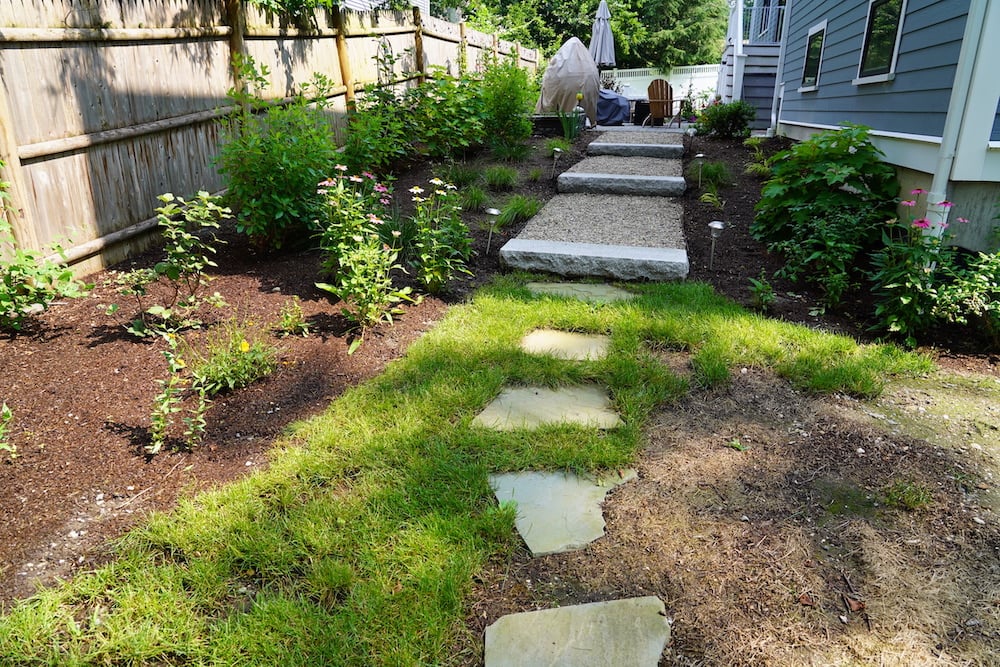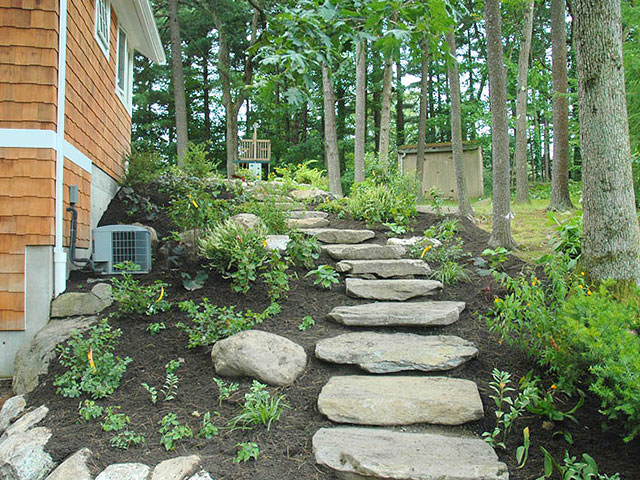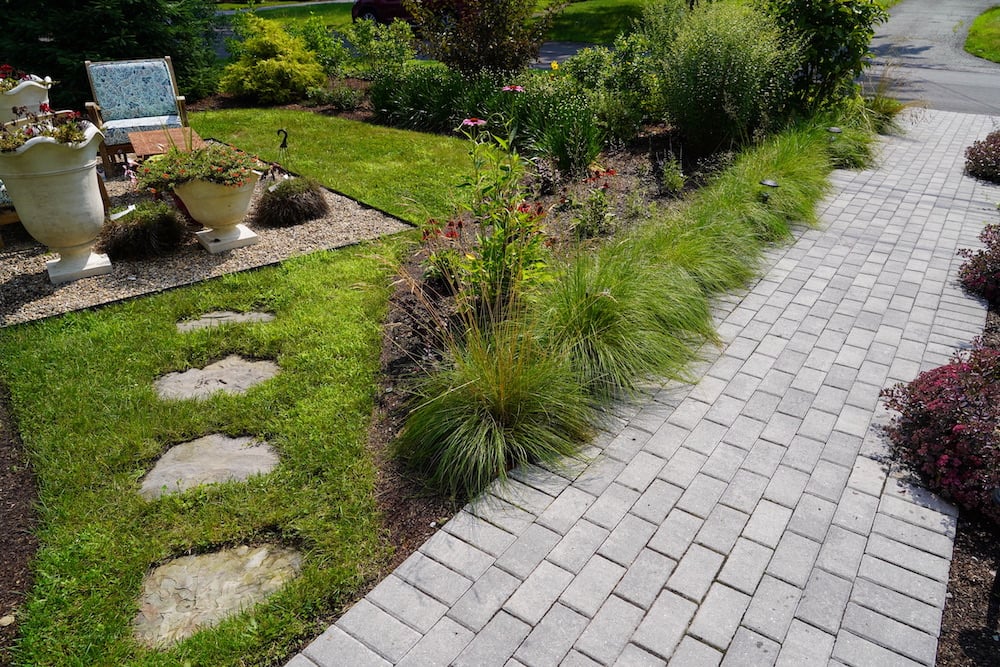Are you planning an outdoor renovation project of your landscape? Or have you already made investments in your property outdoor spaces, but are looking for new landscaping ideas to give a boost to its overall look?
Then it’s time to talk about your outdoor walkway design.
For many homeowners, walkways can be an overlooked element of a home’s overall landscape design. A well-designed outdoor walkway can increase the curb appeal of the home’s exterior, giving a valuable boost to its resale value. Just envision it:
A stunning paver walkway, surrounded by flower beds, leading to a warm and inviting front door.
Maybe it’s a backyard landscaping design featuring a backyard walkway, constructed with bluestone, leading to your home’s outdoor living spaces, such as a fire pit or pergola.
Or perhaps it’s a simple gravel walkway guiding you to your garden paths and garden beds.
Whatever you choose, thoughtful walkway design not only creates a warm, inviting aesthetic for family and friends, but it also maximizes the enjoyment of your outdoor space.
Giving your outdoor walkways a makeover to provide eye-catching, visual interest in your home’s landscape isn’t the only benefit of undertaking a project like this. A modernized walkway design, which incorporates safety elements, can improve the accessibility of the property. This is particularly important for older homeowners, as incorporating these elements ensure they can age in place and stay in their homes longer.

Safety Considerations for Outdoor Walkways
Are you considering going the DIY route for your new outdoor walkway? You should proceed with caution — especially if you’re keeping safety in mind. The choice of materials is crucial for walkway safety. A professional landscape design company has the expertise on the best materials suited for your unique space to create a walkway that combines beauty and safety.
Durable and Non-Slip Surfaces
Incorporating non-slip hardscape materials is an important way you can ensure your walkway’s safety stability. You’ll also want to consider when to use porous or non-porous options in the overall design. Porous materials reduce water accumulation and puddles, reducing the risk of falls, while helping the walkway materials stay in place.
If you’re using nonporous materials, you should consider the drainage implications. Additionally, durable materials will reduce cracks and uneven surfaces, ensuring your walkway’s safety while keeping it low maintenance.
Climate Conditions
It is crucial to consider your overall climate when modernizing your walkway. Various materials will have different responses to extreme weather conditions, such as temperature and precipitation. For safety considerations, it’s important to be mindful of which materials become slippery in heavy rain or snow. Also, some materials may heat significantly during the summer, which is something to think about if you like to spend time in sandals — or even barefoot — outside.
Clearing Debris
Walkways are truly low maintenance overall, but it is important to sweep the walkway of leaves, snow, or debris and ensure paths remain clean. These can all be slipping hazards and also detract from the beauty of your outdoor space.
Outdoor Lighting
The right lighting addresses both safety and design concerns. Making sure light fixtures are evenly distributed around walkways will mitigate tripping concerns in the evenings. You can also opt for solar powered or LED options, which require minimal maintenance and lower energy costs.
Motion sensor lights also are great for enhanced visibility, and can deter potential unwanted intruders. For any dog owners, it makes the nighttime routine much easier as well! The options for outdoor lighting are nearly endless and can be incorporated into any design theme.
Accessibility Concerns
A good rule of thumb is that your walkway is wide enough to accommodate two people side by side. It should also be far enough away from walls or other structures to avoid a cramped path and mitigate injury risk from a fall. Finally, to be mindful of accessibility concerns such as wheelchairs or strollers, particularly on a main path in the front yard.

Types of Materials for a Safe Outdoor Walkway
As we’ve already discussed, there are several hardscape materials that can be used to build a safe and stylish outdoor walkway. Here are some of the most commonly used options:
Concrete Pavers
Durable and long lasting, concrete pavers also have nearly limitless design options. They provide a smooth surface when installed properly, which will address the aforementioned safety concerns. Also, pavers won’t develop jagged cracks over time like regular concrete pours. For style, you can use textures, stains or interesting visual looks like a herringbone pattern.
Brick Pavers
Brick pavers offer a timeless and classic look with many benefits. There are many porous varieties, which helps reduce slipperiness. They are also low maintenance, as damaged bricks can be individually replaced, rather than tearing up an entire walkway.
Natural Stone
Natural flagstone is beautiful, durable, and upscale, but can be more expensive and take longer to install. Flagstone can also be textured to provide slip resistance. Often used for more rustic design looks, flagstone can be cut into a more formal, smooth design. Slate shares many similarities with flagstone from a safety perspective, but is cheaper and easier to install.
Stepping Stone
Stepping stone walkways offer great flexibility and address accessibility, durability, and slippage concerns. They offer a simple, low profile design choice that can incorporate concrete pavers and flagstone. You can customize your design by incorporating various grass, planting beds or mulch nearby.
Gravel
Although pea gravel might not be the most accessible to wheelchairs and strollers compared to the other options, if it is compacted tightly, it can still work fine. The natural and permeable surface will prevent standing water and slippage concerns. One factor to keep in mind is that it does require periodic maintenance to replenish and level the surface.
A great outdoor walkway design helps your home look great and stay safe and accessible for both you and family and friends alike. A professional landscape design company can partner with you to not only offer you design ideas for your walkway, but pair it with the expertise necessary for a successful build and installation.
To learn more about adding a hardscape like an outdoor walkway to your home landscape, please download our free ebook, The Expert Guide to Building the Custom Home Hardscape of Your Dreams.





